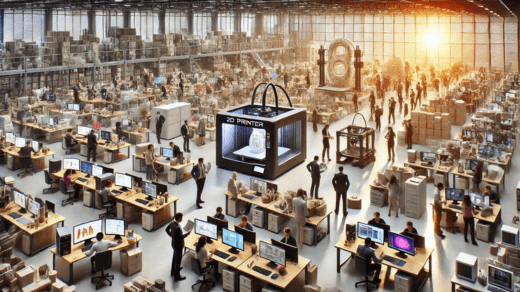In today’s rapidly advancing technological landscape, 2D and 3D printers have revolutionized the way we create and produce. Whether you’re a hobbyist, a professional, or a business, understanding the different types of printers and their applications can significantly impact your productivity and creativity. This article delves into the world of 2D and 3D printers, highlighting their benefits and how models like the anycubic kobra 2 are setting new standards in 3D printing technology.
1. Understanding 2D Printers: Essential for Everyday Tasks
2D printers are ubiquitous in homes and offices around the world. They are designed to produce two-dimensional outputs, primarily on paper. These printers come in several types, each serving different purposes:
Inkjet Printers: Inkjet printers are versatile and affordable. They are known for their ability to produce high-quality color prints, making them ideal for printing photos, graphics, and everyday documents. Inkjet printers use liquid ink sprayed through tiny nozzles onto paper, resulting in rich colors and fine details.
Laser Printers: Laser printers use toner to create sharp, high-resolution text and graphics. They are known for their speed and efficiency, making them perfect for high-volume printing tasks. Laser printers are commonly used in office environments where large quantities of documents are printed regularly.
All-in-One Printers: These multifunctional devices combine printing, scanning, copying, and sometimes faxing capabilities. They are ideal for users who need a single machine to handle various tasks, saving both space and money. All-in-one printers are popular in both home and office settings due to their convenience and versatility.
2. The Rise of 3D Printing: Transforming Creativity and Production
3D printing, also known as additive manufacturing, represents a significant leap forward from traditional 2D printing. This technology creates three-dimensional objects by adding material layer by layer based on digital models. Here are some key aspects of 3D printing:
Fused Deposition Modeling (FDM): FDM is the most common 3D printing technology used by hobbyists and professionals alike. It works by melting plastic filaments and extruding them through a nozzle to build up the object layer by layer. FDM printers are known for their affordability and ease of use.
Stereolithography (SLA): SLA printers use a laser to cure liquid resin into solid layers. This technology offers high precision and smooth surface finishes, making it ideal for detailed prototypes and complex parts. SLA printers are often used in industrial applications where accuracy is crucial.
Selective Laser Sintering (SLS): SLS printers use a laser to fuse powdered materials into solid objects. This method is highly durable and can work with a range of materials, including plastics and metals. SLS is often employed in manufacturing and engineering for producing functional parts.
3. Spotlight on the anycubic kobra 2: A Game-Changer in 3D Printing
When it comes to cutting-edge 3D printing technology, the anycubic kobra 2 stands out as a noteworthy model. This 3D printer combines advanced features and user-friendly design, making it a popular choice for both beginners and experienced users.
Key Features of the anycubic kobra 2:
1. Auto-Leveling System: The anycubic kobra 2 features an automatic bed leveling system that ensures optimal print quality and accuracy. This technology eliminates the need for manual adjustments, making the printing process more straightforward and hassle-free.
2. Large Build Volume: With its generous build volume, the anycubic kobra 2 can accommodate larger prints, allowing users to create more substantial and intricate designs. This feature is particularly useful for users who need to print larger prototypes or functional parts.
3. Enhanced Print Speed: The anycubic kobra 2 boasts impressive print speeds, reducing the time required to complete large or complex prints. This efficiency is a significant advantage for users who need to produce multiple items quickly.
4. High Precision: Thanks to its advanced technology, the anycubic kobra 2 delivers high precision and excellent print quality. This ensures that even the most detailed models come out as intended, with smooth surfaces and accurate dimensions.
5. User-Friendly Interface: The printer’s intuitive interface and touchscreen controls make it easy to navigate through settings and manage prints. This user-friendly design helps streamline the printing process, making it accessible for users of all skill levels.
4. Choosing the Right Printer for Your Needs
Selecting the right printer depends on your specific requirements and intended applications. For everyday document printing and high-quality photo output, a 2D printer such as an inkjet or laser printer is ideal. However, if you’re looking to explore the possibilities of three-dimensional design and production, a 3D printer like the anycubic kobra 2 offers an excellent entry point.
Considerations for Choosing a 3D Printer:
- Purpose: Determine whether you need a printer for prototyping, manufacturing, or personal projects.
- Material Compatibility: Choose a printer that supports the materials required for your applications.
- Budget: Factor in both the initial cost of the printer and the ongoing costs of materials and maintenance.
5. Conclusion
The world of printing continues to evolve, offering new opportunities for creativity and productivity. Whether you need a reliable 2D printer for everyday tasks or a cutting-edge 3D printer like the anycubic kobra 2 for advanced projects, understanding the features and benefits of each type can help you make the best choice. Explore your options and embrace the technology that best suits your needs, and you’ll be well on your way to achieving your printing goals.

